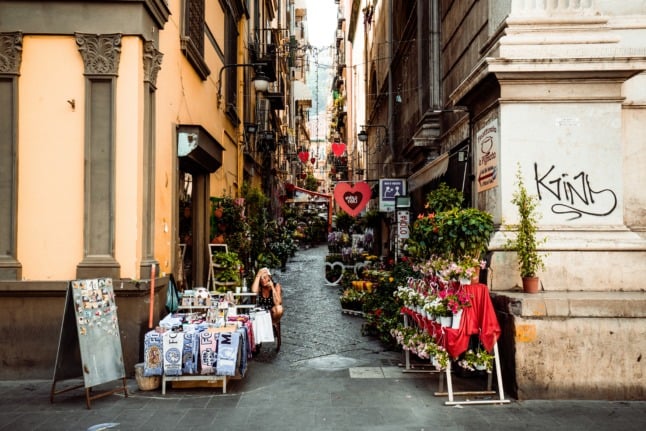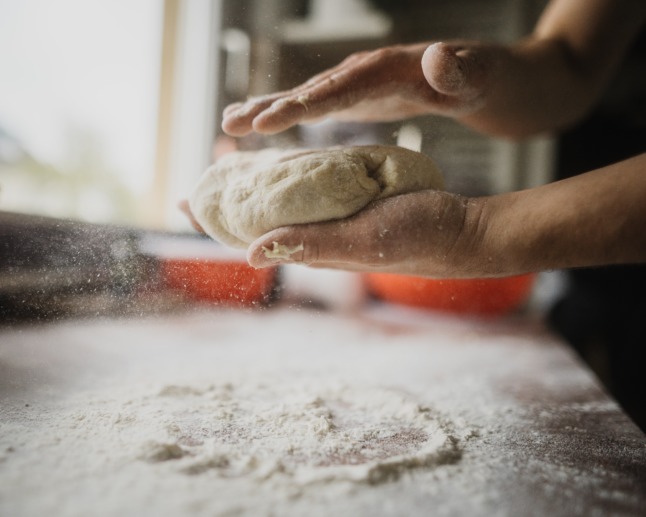Eight surprising pizza facts in honour of Italy's most beloved export

Happy World Pizza Day! In honour of the event, here are ten things you might not know about Italy's favourite cheesy treat.
Pasta may rank more highly on the list of cultural and gastronomic exports Italians are most proud of, but it could be argued that pizza is more widely loved.
A 2018 survey found that 52 percent of Italians rated pizza as their favourite dish, with 39 percent saying it satisfied them 'on an emotional level'.
And it's not hard to see why: that stretchy dough, sweet and tangy tomato sauce and melty mozzarella make it the ultimate comfort food.
In tribute to the carbohydrate-laden delight that is pizza, and to mark to the occasion of World Pizza Day, here are some facts you may not know about the dish.
READ ALSO: Ten surprising pasta facts in honour of Italy’s favourite food
It comes from Naples
While flat breads with toppings have been around for millennia, what we think of as pizza today comes from the southern Italian city of Naples.
The first recorded use of the word pizza has been traced back to a Latin text from the coastal city of Gaeta, north of Naples, in 997, and by the 16th century, pizza – which usually consisted of bread served with cheese and lard or small fish – had become a popular Neapolitan peasant street food.
It wasn’t until the eighteenth century that tomatoes, which were brought to Italy from the Americas and were initially feared to be poisonous, started to be used in pizza.

Naples is the birthplace of Italian pizza. Photo by Sam van Bussel on Unsplash
The Margherita is (according to lore) named after an Italian queen
The pizza Margherita allegedly got its name after it was cooked for Queen consort Margherita of Savoy by Neapolitan pizza maker Raffaele Esposito in honour of her 1889 visit to Naples.
The red of the tomato paste, white of the mozzarella, and green of the basil leaves is said to represent the red, white and green of the Italian flag, as the country had recently undergone unification.
In reality, a tomato-based pizza topped with mozzarella and basil had already been around for many decades - and according to one writer from the era, the mozzarella and basil were often arranged into a flower formation, which could be the real origin of the name margherita (daisy in Italian).
Nonetheless, if you go to Pizzeria Brandi in Naples, where Esposito worked, you’ll find a plaque dated 1989 which says “Here 100 years ago the Pizza Margherita was born”.
READ ALSO: The must-try foods from every region of Italy
It’s been to space
The first pizza to exit the earth’s orbit was sent to Yuri Usachov on the International Space Station in 2001.
Pizza Hut had the salami (not pepperoni, as it goes bad too quickly) pizza delivered to the astronaut via a Russian rocket.
The company reportedly paid the Russian space agency $1 million for the publicity stunt, which bought them a picture of Usachov giving a thumbs up to the camera after eating the pizza and their logo displayed on the side of a rocket.

The International Space Station, in which astronaut Yuri Usachov consumed a pizza. Photo by NASA on Unsplash
There are strict rules governing what counts
Italians are nothing if not protective of their culinary traditions, with entire social media accounts and British chat show segments dedicated to Italians getting exercised about any perceived disrespect to their national dishes.
happy #worldpizzaday pic.twitter.com/zFatKexQlq
— italians mad at food (@ItalianComments) January 17, 2022
READ ALSO: ‘Disgusting knockoffs’: Italians warn foreign cooks over carbonara recipes
When it comes to pizza, the Associazione Verace Pizza Napoletana (True Neapolitan Pizza Association) has taken it upon itself to draw up some boundaries as to exactly what does and doesn’t count as real Neapolitan pizza, to afford the dish ‘maximum dignity’.
As well as having the correct ingredients (preferably from the Campania region), the pizza must have a diameter of no more than 35 cm, a crust of 1-2cm, be cooked at 430-480C° for between 60 and 90 seconds, and be ‘soft and fragrant’, the association says.
Needless the say, it should never, ever have pineapple as a topping.
Neapolitan pizza-making has UNESCO world heritage status
The craft of the Neapolitan pizzaiolo (pizza-maker) hasn’t just been catalogued by a local organisation; in 2017 it was also enshrined by the United Nations Educational, Scientific and Cultural Organization as a protected tradition.
It’s not pizza itself, but the art of Neapolitan pizza-making that received UNESCO world heritage status. It’s a unique cultural and gastronomic tradition that involves twirling the pizza in the air and encompasses the ritual of singing, story-telling and back-and-forth banter between the pizzaiolo and local customers.
READ ALSO: The ten ‘unbreakable’ rules for making real Italian pasta alla carbonara

Neapolitan pizza-making is now a UNESCO-protected art. Photo by Max Saeling on Unsplash
It gave its name to the ‘pizza effect’
It may surprise non-Italians to hear that for hundreds of years, pizza just wasn’t that popular in Italy outside of Naples.
That didn’t change until Neapolitans started to emigrate to the US in the early 20th century, and American soldiers that had been stationed in Naples during World War II brought their love of pizza back home with them. Pizza exploded in America, and Italy took note. Pizzerias started popping up all over the country, and the dish was embraced as a national treasure.
This phenomenon – whereby an item with little cultural value in its own country becomes extremely popular abroad, and as a result is reevalutated and granted a higher status in its country of origin – was observed by the anthropologist Agehananda Bharati, who termed it the ‘pizza effect’.
READ ALSO: Ten of the most delicious street foods in Italy
The world’s largest pizza was made in Rome
The world’s largest pizza, according to the Guinness World Records, was made in Rome.
It had a surface area of more than a kilometre (1,261.65 m²), was presented by five Italians at the Fiera Roma event space on December 13, 2012, was named Ottavia, and was entirely gluten-free, the Guinness World Records' website reports.
The record for the world's longest pizza (almost 2km, or 1,930.39 m) was set in Fontana, California in 2017, while the largest commercially available pizza is sold at Moontower Pizza Bar in Texas, where should they desire, customers can order 'The Bus', which costs $299.95 and has a surface area of almost two metres.
READ ALSO: Five delicious Italian food idioms, explained
... But Italy isn't the world's biggest consumer of pizza
It may not surprise you all that much to hear that Italy isn't the largest consumer of pizza - after all, there are only about 60 million Italians to America's population of 330 million.
But Italy doesn't get the prize for the most pizza consumed per capita either - and nor, for that matter, does the US.
That title goes to Norway, where the average person apparently consumes 5kg of pizza per year. Most of that consumption, of course, is in the form of frozen pizzas, which many Italians wouldn't want to touch.
On a global level, an estimated five billion pizzas are sold every year and 350 slices consumed every second, according to the travel site BootsnAll.
Comments (4)
See Also
Pasta may rank more highly on the list of cultural and gastronomic exports Italians are most proud of, but it could be argued that pizza is more widely loved.
A 2018 survey found that 52 percent of Italians rated pizza as their favourite dish, with 39 percent saying it satisfied them 'on an emotional level'.
And it's not hard to see why: that stretchy dough, sweet and tangy tomato sauce and melty mozzarella make it the ultimate comfort food.
In tribute to the carbohydrate-laden delight that is pizza, and to mark to the occasion of World Pizza Day, here are some facts you may not know about the dish.
READ ALSO: Ten surprising pasta facts in honour of Italy’s favourite food
It comes from Naples
While flat breads with toppings have been around for millennia, what we think of as pizza today comes from the southern Italian city of Naples.
The first recorded use of the word pizza has been traced back to a Latin text from the coastal city of Gaeta, north of Naples, in 997, and by the 16th century, pizza – which usually consisted of bread served with cheese and lard or small fish – had become a popular Neapolitan peasant street food.
It wasn’t until the eighteenth century that tomatoes, which were brought to Italy from the Americas and were initially feared to be poisonous, started to be used in pizza.

The Margherita is (according to lore) named after an Italian queen
The pizza Margherita allegedly got its name after it was cooked for Queen consort Margherita of Savoy by Neapolitan pizza maker Raffaele Esposito in honour of her 1889 visit to Naples.
The red of the tomato paste, white of the mozzarella, and green of the basil leaves is said to represent the red, white and green of the Italian flag, as the country had recently undergone unification.
In reality, a tomato-based pizza topped with mozzarella and basil had already been around for many decades - and according to one writer from the era, the mozzarella and basil were often arranged into a flower formation, which could be the real origin of the name margherita (daisy in Italian).
Nonetheless, if you go to Pizzeria Brandi in Naples, where Esposito worked, you’ll find a plaque dated 1989 which says “Here 100 years ago the Pizza Margherita was born”.
READ ALSO: The must-try foods from every region of Italy
It’s been to space
The first pizza to exit the earth’s orbit was sent to Yuri Usachov on the International Space Station in 2001.
Pizza Hut had the salami (not pepperoni, as it goes bad too quickly) pizza delivered to the astronaut via a Russian rocket.
The company reportedly paid the Russian space agency $1 million for the publicity stunt, which bought them a picture of Usachov giving a thumbs up to the camera after eating the pizza and their logo displayed on the side of a rocket.

There are strict rules governing what counts
Italians are nothing if not protective of their culinary traditions, with entire social media accounts and British chat show segments dedicated to Italians getting exercised about any perceived disrespect to their national dishes.
happy #worldpizzaday pic.twitter.com/zFatKexQlq
— italians mad at food (@ItalianComments) January 17, 2022
READ ALSO: ‘Disgusting knockoffs’: Italians warn foreign cooks over carbonara recipes
When it comes to pizza, the Associazione Verace Pizza Napoletana (True Neapolitan Pizza Association) has taken it upon itself to draw up some boundaries as to exactly what does and doesn’t count as real Neapolitan pizza, to afford the dish ‘maximum dignity’.
As well as having the correct ingredients (preferably from the Campania region), the pizza must have a diameter of no more than 35 cm, a crust of 1-2cm, be cooked at 430-480C° for between 60 and 90 seconds, and be ‘soft and fragrant’, the association says.
Needless the say, it should never, ever have pineapple as a topping.
Neapolitan pizza-making has UNESCO world heritage status
The craft of the Neapolitan pizzaiolo (pizza-maker) hasn’t just been catalogued by a local organisation; in 2017 it was also enshrined by the United Nations Educational, Scientific and Cultural Organization as a protected tradition.
It’s not pizza itself, but the art of Neapolitan pizza-making that received UNESCO world heritage status. It’s a unique cultural and gastronomic tradition that involves twirling the pizza in the air and encompasses the ritual of singing, story-telling and back-and-forth banter between the pizzaiolo and local customers.
READ ALSO: The ten ‘unbreakable’ rules for making real Italian pasta alla carbonara

It gave its name to the ‘pizza effect’
It may surprise non-Italians to hear that for hundreds of years, pizza just wasn’t that popular in Italy outside of Naples.
That didn’t change until Neapolitans started to emigrate to the US in the early 20th century, and American soldiers that had been stationed in Naples during World War II brought their love of pizza back home with them. Pizza exploded in America, and Italy took note. Pizzerias started popping up all over the country, and the dish was embraced as a national treasure.
This phenomenon – whereby an item with little cultural value in its own country becomes extremely popular abroad, and as a result is reevalutated and granted a higher status in its country of origin – was observed by the anthropologist Agehananda Bharati, who termed it the ‘pizza effect’.
READ ALSO: Ten of the most delicious street foods in Italy
The world’s largest pizza was made in Rome
The world’s largest pizza, according to the Guinness World Records, was made in Rome.
It had a surface area of more than a kilometre (1,261.65 m²), was presented by five Italians at the Fiera Roma event space on December 13, 2012, was named Ottavia, and was entirely gluten-free, the Guinness World Records' website reports.
The record for the world's longest pizza (almost 2km, or 1,930.39 m) was set in Fontana, California in 2017, while the largest commercially available pizza is sold at Moontower Pizza Bar in Texas, where should they desire, customers can order 'The Bus', which costs $299.95 and has a surface area of almost two metres.
READ ALSO: Five delicious Italian food idioms, explained
... But Italy isn't the world's biggest consumer of pizza
It may not surprise you all that much to hear that Italy isn't the largest consumer of pizza - after all, there are only about 60 million Italians to America's population of 330 million.
But Italy doesn't get the prize for the most pizza consumed per capita either - and nor, for that matter, does the US.
That title goes to Norway, where the average person apparently consumes 5kg of pizza per year. Most of that consumption, of course, is in the form of frozen pizzas, which many Italians wouldn't want to touch.
On a global level, an estimated five billion pizzas are sold every year and 350 slices consumed every second, according to the travel site BootsnAll.
Join the conversation in our comments section below. Share your own views and experience and if you have a question or suggestion for our journalists then email us at [email protected].
Please keep comments civil, constructive and on topic – and make sure to read our terms of use before getting involved.
Please log in here to leave a comment.